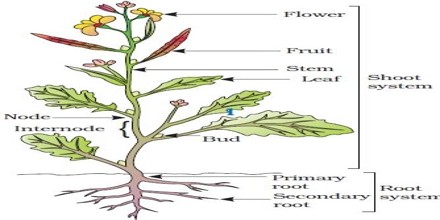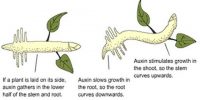An ideal flowering plant can be divided into root, stem, leaves, flower, and fruit, etc. The flower is the plant part where seeds are made to make more plants of its type.
Shoot: The part of the plant that remains above the soil is called shoot. Shoot consists of stems, leaves, flowers, and fruit. The stem has the node, internode, and apical bud. The flowers grow at the axis of the leaves. Flowers have calyx, androcium, Corolla, and ovary.
Let examine the parts using the diagram of the chili plant given. The key parts of a flower that are vital for its function are it’s male and female parts, the carpel and the stamen.

- Stem: It is the part of the plant connected to the taproot and remains above the soil. It provides support for the plant and allows nutrients and water to move throughout the plant. The stem has a node and internode. Leaves originate from the nodes. Within the stem and all over the plant are tube-like tissues called xylem and phloem. The stem bears the weight of leaves and branches. These tissues carry water, food, and nutrients to all parts of the plant.
- Leaves: It is a thin, extended green outgrowth of the stem and the branches. They are the sites of food production for the flowering plant. Food is produced in the leaves. It is here that the plant acquires light energy and carbon dioxide for photosynthesis and releases oxygen into the air. Leaves can have a variety of shapes and forms
- Flower: In the chili plant, small white flowers grow out of the axis of the leaves. These flowers mature into fruit, e.g. chili.
- Fruit: When flower matures, it falls off. The remaining part of the base of the fallen flower becomes fruit. After maturity, the ovary turns into fruit. The fruit of the chili plant is the chili itself.
- Root: The part of the plant with no node, internode, and an apical bud is the root. Generally, people think that the part of the plant that remains below the soil is the root. In most cases, this is worth saying. However, in special cases, stem, leaves, flower, and fruit grows under the soil.
For example ginger, turmeric, onion, etc. You will learn more about it in the higher class.
Roots usually develop from radicals. Leaves, fruits or flowers do not grow, on roots. Roots generally grow downwards. The radical grows into the taproot. Secondary root originates from tap (primary) roots; similarly, tertiary root originates from secondary roots. Flowers are accountable for seed improvement and reproduction. There are four main flower parts in angiosperms: sepals, petals, stamens, and carpels.
- Sepal – The outer parts of the flower that enclose a developing bud.
- Petal – The parts of a flower that are often conspicuously colored.
- Stamen – The pollen-producing part of a flower, usually with a slender filament supporting the anther.
- Carpels – The part of the stamen where pollen is produced.
- Ovary – They form the base of the pistil. The ovary holds the ovules.














